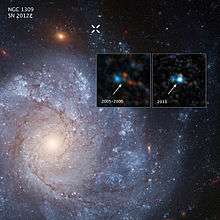Zombie star
A zombie star is a hypothetical result of a Type Iax supernova which leaves behind a remnant star, rather than completely dispersing the stellar mass.[1][2][3][4][5] Type Iax supernovae are similar to Type Ia, but have a lower ejection velocity and lower luminosity.[6] Scientists think that Type Iax supernovae occur at a rate between 5 and 30 percent of the Ia supernova rate. Thirty supernovae have been identified in this category.[7]
In a binary system consisting of a white dwarf and a companion star, the white dwarf strips away material from its companion. Normally the white dwarf would eventually reach a critical mass, and fusion reactions would make it explode and completely dissipate it, but in a Type Iax supernova, only half of the dwarf's mass is lost.[8]

Observed instances
Supernova SN 2012Z in the NGC 1309 galaxy is thought to be of Type Iax, and was discovered in 2012 by S. B. Cenko, W. Li, and A. V. Filippenko using the Katzman Automatic Imaging Telescope on January 29.15 UT as part of the Lick Observatory Supernova Search. It is believed that the more massive of the binary stars at the heart of the supernova lost substantial amounts of its hydrogen and helium to its smaller companion, becoming a white dwarf. The companion star then became larger and engulfed the white dwarf, ejecting the outer hydrogen layers of the combined star and leaving behind a helium core. In turn, the white dwarf drained matter from the companion star until the dwarf became so unstable that it exploded as a supernova, with a zombie star left behind as a remnant.[3]
There were images of the area from before the supernova, allowing before and after images, and the process of the supernova to be studied. To confirm the zombie star hypothesis, the area will be photographed again in 2015 after the supernova's light dims enough to allow further study. The discoverers have stated that there is a 99% chance that the star in the "before" photograph is related to the supernova, and not a coincidence. The scientists said that one other hypothesis for the observation could be that a super-massive star 30 to 40 solar masses may have detonated as well.[8]
This discovery is a milestone in a decades long search by astronomers for such an occurrence; the observation of SN 2012Z was the first time scientists were able to identify a star system that later went supernova.[8]
Scientists also believe that SN 2008ha may be a Type Iax supernova, but significantly weaker than SN 2012Z.[3]
References
- ↑ Hubbard, Amy (6 August 2014). "Hubble sees 'zombie star' lurking in space: What it is, why it matters". Los Angeles Times. latimes.com. Retrieved 30 October 2014.
- ↑ "Hubble discovers 'zombie star' haunting the universe". CNET. Retrieved 30 October 2014.
- 1 2 3 Weaver, Donna; Villard, Ray (6 August 2014). "NASA's Hubble Finds Supernova Star System Linked to Potential "Zombie Star"". HubbleSite - NewsCenter. NASA. Retrieved 30 October 2014.
- ↑ "Zombie star: Hubble spots star SN 2012Z living after supernova.". Slate Magazine (Video). 12 August 2014. Retrieved 30 October 2014.
- ↑ Hauk, Alexis (6 August 2014). "Hubble Finds Supernova Star System Linked to Potential "Zombie Star"". Time Magazine. Retrieved 30 October 2014.
- ↑ McCully, Curtis; Jha, Saurabh W.; Foley, Ryan J.; Bildsten, Lars; Fong, Wen-fai; Kirshner, Robert P.; Marion, G. H.; Riess, Adam G.; Stritzinger, Maximilian D. (7 August 2014). "A luminous, blue progenitor system for the Type Iax supernova 2012Z". Nature. 512 (512): 54–56. arXiv:1408.1089
 . Bibcode:2014Natur.512...54M. doi:10.1038/nature13615. PMID 25100479. Retrieved 30 October 2014.
. Bibcode:2014Natur.512...54M. doi:10.1038/nature13615. PMID 25100479. Retrieved 30 October 2014. - ↑ Feltman, Rachel. "Astronomers may have found a new zombie star". Washington Post. Retrieved 30 October 2014.
- 1 2 3 Choi, Charles Quixote (6 August 2014). "Supernovas Might Create Weird 'Zombie Stars'". Space.com. Retrieved 30 October 2014.